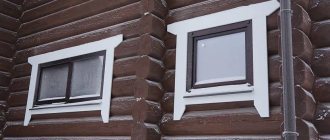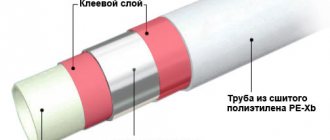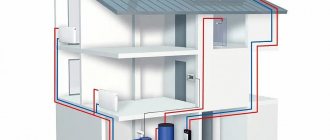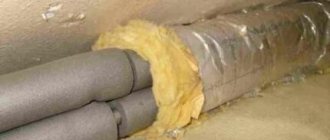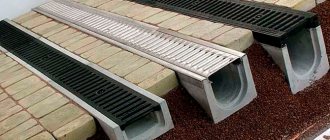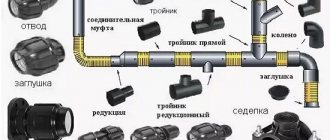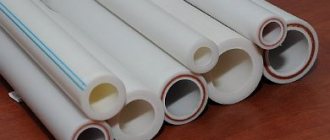Underground installation of heating mains for industrial purposes is not uncommon, since it is often impossible to place large-diameter pipes above ground level, especially in urban areas. It is better to lay the heating pipeline of a private house, if the boiler room is located in a separate building, above the ground, but sometimes circumstances also force it to be done in a trench.
Laying heating pipes in the ground deprives the consumer of the opportunity to visually monitor the condition of the pipeline, therefore, in this case, increased demands are placed on the quality of work performed. In addition, a heating pipe buried in the ground is affected by a number of additional, specific factors that must be taken into account. Let's consider these factors and the current rules for performing the necessary work in order to correctly lay heating pipes underground.
Why do you need thermal insulation of pipelines?
Steel and plastic pipes used for water supply, sewerage and heating systems do not always require insulation. But in many cases it is necessary if the owners of the house are not ready to be left without water or heat in the middle of winter and spend money on repairing communications.
- Thermal insulation for water supply pipes is required if they are laid below the freezing level of the soil, on the surface of the ground, or pass through unheated rooms. Without it, the water in them will freeze in winter, which will most likely lead to damage to the pipes and components themselves. This is fraught not only with inconvenience associated with the lack of water, but also with the need for repairs, which is preceded by a search for damaged areas. In the case of steel pipes, insulation has another goal: eliminating condensation in hot weather.
Broken tap Source avatars.mds.yandex.net
- Insulation of heating pipelines is also necessary when they pass through a cold zone: in walls, underground or along the street (for example, from a separate boiler room into a house). In such cases, high heat loss occurs, and the coolant reaches the consumer very cold, which negatively affects the efficiency of the heating system and increases the cost of maintaining a comfortable temperature.
The heating main in the basement needs insulation Source napetrovskoi.ru
- Insulation is least often required for gravity sewer systems, since they have an open spout and work to remove warm wastewater. The need for insulation arises if the pipes are laid shallow, with too little slope, or have a large length or turns. And also if the house is not equipped with hot water supply. Traffic jams and jams may appear in them, creating ideal conditions for freezing.
Note! Thermal insulation materials, in addition to their main function, can perform another function - sound insulation. Therefore, sometimes they are used precisely for this purpose.
Types of pipe insulation
Thermal insulation of pipelines is made of different materials. Their choice depends on many factors, including the purpose and location of the highways, their diameter, cost, and operating conditions. For example, for underground installation they choose insulation that is not afraid of moisture, and for insulation of heating pipes - one that is not to the liking of rodents who want to settle closer to warmth during the cold season.
Thermal insulation of an underground main Source znatoktepla.ru
But regardless of all these factors, any pipe insulation must meet the following requirements :
- have low thermal conductivity to retain heat inside and keep cold out;
- do not absorb moisture , which worsens the thermal insulation properties of the material;
- resist fire or be self-extinguishing;
- be resistant to mechanical stress;
- easy to install both on existing and existing communications.
Not all thermal insulation materials can boast all of the listed advantages. Therefore, thermal insulation for pipes can be produced with a protective shell, reinforcement, fire-resistant or moisture-proof impregnation.
Let's take a closer look at all types of such insulation.
Fiber insulation
These are the most popular materials until recently, characterized by excellent heat-saving properties. Depending on the raw materials for production, they are divided into several types:
- glass wool - made from glass production waste, has excellent resistance to chemicals, does not burn, and does not attract the attention of rodents;
Rolled glass wool Source pro-uteplenie.ru
- slag wool from waste from the metallurgical industry is used only for insulating external pipes, as it emits substances harmful to health;
- mineral (basalt) wool is a product of processing basalt rocks. It is characterized by mechanical resistance, fire resistance, and excellent thermal insulation characteristics.
The main disadvantage of all fiber insulation is that they absorb water well, losing their heat-insulating properties. Therefore, they are either impregnated with water-repellent agents or isolated from moisture with an outer protective layer made of materials such as roofing felt, foil-isolon, glassine. These actions complicate installation and increase the time spent on it.
Penetrating between the fibers, water displaces air and deprives the material of its insulating properties Source img.archiexpo.com
See also: Catalog of companies that specialize in water supply and sewerage.
Fiber thermal insulation for pipes is available in rolls of different thicknesses or in the form of hollow cylinders with an internal diameter of different sizes corresponding to the outer diameter of the pipes. The materials may have an outer waterproof shell. For ease of installation, cylinders are usually cut lengthwise, and an adhesive layer covered with a protective film is applied to the cut plane.
Which insulation option is better?
When choosing insulation for heating system pipes, you must consider:
- Location of the line (in the ground, in the basement, in the attic).
- Presence of problems with rodents.
- Financial opportunities.
- Pipe diameter and pipeline configuration.
- Coolant heating temperature.
In practice, rats and mice only avoid glass wool. Plus the paint is simply too much for them. They may well chew through the rest of the insulation in order to fill their nest.
If the street heating line is being insulated, then it is recommended to use moisture-resistant rigid foam or polyurethane foam, which are less likely to get wet
Polyethylene in all its variations is resistant to the aggressive effects of cement. If a pipe with insulation is laid in a wall and then the hole is filled with concrete, then polyethylene material should be preferred.
Polyurethane foam allows you to reach all sections of the highway, reliably covering it with a monolithic thermal insulation layer. However, special equipment is required to apply it. Plus, it is difficult to spray such insulation onto thin pipes; most of the foam will end up on the surrounding walls.
When installing a heating system in areas with unstable soils and connecting several buildings to one boiler, the most optimal insulation is lightweight polyethylene or thin polystyrene foam. It is not worth using heavy stone wool here. When the soil moves, highways may not withstand additional loads and burst.
Video description
The following video shows how mineral wool cylinders are mounted on a pipeline:
Insulation made of polystyrene foam and polystyrene foam
Insulating pipes with foam plastic is the simplest and most inexpensive way to insulate them. This material has all the necessary properties: it does not burn, withstands stress well, does not emit toxic substances, almost does not absorb water, is very easy to install and can be used repeatedly. Its only drawback is its attractiveness to mice and other rodents. Which, however, is unimportant when insulating underground pipelines, for which it is most often used.
Extruded polystyrene foam has even better technical characteristics - it is denser and more moisture-resistant, and better resists the destructive effects of ultraviolet rays.
Both materials are produced in the form of so-called shells - sections that are halves of a cylinder with a tongue-and-groove connection. They can be covered with a protective foil shell. This design allows the insulation to be used repeatedly, removing it for inspection or repair of communications.
“Shell” for insulating foam pipes Source standartt.ru
The high density and compressive strength that such thermal insulation of pipelines has allows it to be used both for external pipes and for underground pipelines without installing rigid trays. For various nodes and turns, corresponding shaped shells are produced.
To lay several pipes or large-diameter pipes, special multi-profile segments or slabs of polystyrene foam or expanded polystyrene can be used, from which strips are cut and the box is assembled. Its walls are fastened with polyurethane foam.
Warm polystyrene box Source i.ytimg.com
For reference! Foam glass has similar properties and characteristics, characterized by absolute waterproofness, non-flammability, inertness to chemicals, but also a high price. The form of production of pipe insulation from this material is shells, segments, shaped parts.
Polyurethane foam insulation
Polyurethane foam is one of the most modern insulation materials, which is a cellular polymer material whose closed cavities are filled with carbon dioxide. It makes very effective thermal insulation for heating and water supply pipes.
On sale you can find pipes already insulated with polyurethane foam and covered with a protective sheath: polyethylene for underground installation and galvanized steel for surface installation.
Source https://ks-teplo.ru/assets/images/%D0%9F%D0%9F%D0%A3.jpg
Advantages of polyurethane
Thermal insulation made of polyurethane is called a shell. It is classified as rigid insulation. The polyurethane base contains ribs and walls.
The advantages of a heat insulator include the following qualities:
- Does not have an unpleasant odor;
- When heated, it does not release toxic compounds;
- Resists rotting processes;
- Not dangerous to human health;
- Has good dielectric characteristics;
- It is durable;
- Resists mechanical damage;
- Can be used in the ground, indoors and outdoors.
In addition to the advantages, there is one significant drawback. It lies in the high cost of the material. The fact is that for its production they use a certain technology and expensive consumable raw materials.
Video description
The process of attaching polyurethane foam to a pipe is shown in detail in the video:
- Permanent , but absolutely hermetic insulation of pipelines is carried out by spraying liquid polyurethane foam using special devices. The layer thickness can be made to any size depending on the climatic conditions in the area of operation. The foam material adheres firmly to the pipes, forming a monolithic layer along the entire length of the pipe, including bends and junctions. It perfectly withstands high and low temperatures and its sudden changes without losing its performance characteristics.
The polyurethane foam spraying method allows you to insulate pipes of various configurations and penetrate into hard-to-reach places Source polyol1.rf
Foamed polyethylene
One of the most popular options used in country houses for thermal insulation of communications is insulation for pipes made of foamed polyethylene. Possessing excellent technical characteristics and ease of installation, it also attracts with its flexibility and a large range of standard sizes. This makes it easy to install it with your own hands on pipes of any diameter and purpose.
The structure of the material consists of many small closed cells filled with air, which is the best heat insulator. Insulation for pipes made of foamed polyethylene is produced in the form of rolls with a length of 10 to 30 meters and a thickness of 3 mm to 2 cm. An even more convenient form of release is two-meter flexible pipes with a wall thickness of 6-25 mm and with an internal diameter corresponding to the diameter of the pipes of the most popular sections: from 18 to 160 mm.
Insulation of the popular Energoflex brand Source znatoktepla.ru
Due to the flexibility and elasticity of the material, which is maintained even at extremely low temperatures, it can be mounted on pipelines of any configuration, regardless of weather conditions. Moreover, it is highly hydrophobic and practically does not absorb moisture, does not rot or collapse.
However, foamed polyethylene is afraid of high temperatures. This is a flammable material that begins to deform already at 90 degrees. Therefore, it is not recommended to use it as insulation for heating pipes, and if there are increased fire safety requirements, its use is generally unacceptable.
Possessing almost the same performance characteristics as polyurethane foam and polystyrene foam, foamed polyethylene is much cheaper, which explains its demand and popularity among buyers. Especially if you need to insulate a pipeline of large diameter and length.
Requirements for thermal insulation materials
An ideal heat-insulating layer should have a set of the following characteristics:
- low thermal conductivity coefficient is the main requirement based on the purpose of the material;
- heat resistance - a sufficient degree of resistance to temperature influences while maintaining the main characteristics;
- low flammability - the insulator should not support fire and, moreover, be a means of its spread if a fire occurs in the room;
- dielectric properties - if the grounding device of an electric heating boiler fails, the thermal insulation shell of the pipeline should not become a conductor of electric current;
- acceptable specific gravity - the thermal insulation shell should not create significant additional loads on the pipeline supports;
- lack of hygroscopicity - the material should not absorb and accumulate water from the environment;
- waterproof - the insulating coating must protect the pipeline from corrosion;
- vapor permeability - in case of abnormal wetness, the insulator must dry quickly and restore its thermal insulation properties.
In practice, the materials used to insulate heating pipes outdoors and indoors meet all these requirements to varying degrees, and therefore have both advantages and disadvantages.
When choosing a heat insulator, it is necessary to take into account the conditions of its upcoming operation in order to purchase a shell with the most required properties.
How to install insulation
The installation method depends on the type and form of the insulation, the presence of a protective layer on it, and the need for its installation. If we are talking about fibrous roll or sheet materials, then the installation sequence should be as follows:
- pipes are cleaned of dirt and rust and dried;
- the insulation of the pipes is applied to them in turns with an overlap of several centimeters over the previous layer;
- each turn is secured with wire , twine or tape;
- if foil insulation , roofing felt or other waterproof rolled material over it in the same way
Main advantages
Such a simple and reliable product has gained its popularity for several reasons:
- Insulating properties. Reinforced tape does not conduct electricity, which means it is an analogue of insulating tape. Using such adhesive tape in insulation is a great way to reduce the cost of additional insulating materials.
- The adhesive tape has increased wear resistance and can withstand heavy loads. Reinforced mounting tape is a great way to secure or strengthen something. The material is difficult to tear and this indicates its reliability.
- The tape cannot be stretched over time, which means that all connections fixed with such tape will be securely fastened.
- The long service life of the product is one of its main advantages. Even after several years of operation, the tape will not lose its properties and will be securely fixed.
- Reinforcing tape with fiberglass has the additional feature of withstanding high temperatures. This tape can be used, for example, when installing air ducts or exhaust systems, for example, for the kitchen.
Video description
For another method of installing insulation, see the following video:
If the insulation is made in the form of cylinders, installation is greatly simplified: the elements are simply put on the pipe, and the edges of the cut are glued together, as are the vertical joints between the cylinders. If there is no adhesive layer applied to the edges, then foil tape is used for connection.
Advice! If thermal insulation of an underground pipeline is required, then it is advisable to additionally protect it from moisture by placing it in a large-section plastic pipe.
In the case of insulation made of foam plastic or a similar material in the form of a rigid shell, it is recommended that installation be carried out with the halves of the shells offset along the length by 10-20 cm. This overlap will ensure a more reliable fastening of all elements. During the installation process, all joints are carefully taped.
An offset along the length provides a more reliable fastening Source teplolivada.ru
All kinds of turns, corners, tees and other joints are insulated using shaped parts or homemade boxes made of sheet material. Or they are treated with thin-layer liquid thermal insulation.
Factors affecting heating pipes in the ground
A heating pipe buried in the ground is subject to the same influences as an external pipeline, plus factors caused by burial:
- internal pressure of the coolant, causing circumferential and longitudinal tensile stresses in the pipe section;
- coolant temperature is a factor, in addition to thermal effects, also causing pipeline stress;
- soil temperature - in winter, taking this factor into account is especially important;
- soil deformations - the pipe is affected by any of its displacements (settlement, shear, etc.);
- pre-bending stress of the pipeline - the trench profile often follows the terrain;
- vertical load - the effect of the weight of the trench backfill layer;
- the resistive action of the soil on the walls and bottom of the pipeline - counteracting the vertical load;
- vibration loads - from passing vehicles, excavation work in the neighborhood, etc.;
- moisture – precipitation and groundwater;
- exposure to chemicals - compounds in the soil and coolant;
- biological factor - bacteria, decomposition.
Thus, laying a pipeline in the ground should be done taking into account all of the above factors and solving the question of how to insulate heating pipes in the ground.
Heating electric cable
One of the most effective ways to ensure long-term protection of pipes from freezing is the use of a heating cable. The advantage of this solution is that installation can be done both on top of the pipe and inside it. It all depends on the condition of the pipeline and the diameter of the pipes. When choosing an internal installation method, keep in mind that the cable may reduce the permeability of the pipes if their diameter is too small. The recommended minimum pipe internal diameter size is 40 mm. The heating cable itself can be of two types:
- Resistive;
- Self-regulating.
The latter type is more advanced, convenient and cost-effective. Its cost exceeds the cost of a resistive cable.
However, given that the finished heating system can operate almost completely without human intervention and requires minimal attention, it can be argued that the expense is justified.
A more complete description of both types of heating cable and the features of its selection and installation can be found in our article by following this link.
Rules for installing chimney systems
Before moving on to a review of insulation materials and the rules for working with them, you need to understand the requirements that must be met when installing a chimney. This point is very important, since violation of the standards can lead to the inability to operate the equipment.
Compliance with the standards and requirements for the installation of gas chimneys ensures their reliable and safe operation
Chimney ducts must comply with the requirements of DBN V.2.5-20-2001 and SNiP 2.04.05-91. The basic requirements are as follows:
- The internal diameter of the chimney pipe must be larger than the diameter of the outlet pipe of the gas boiler;
- The main pipe cannot have curved or tapering sections, must be located vertically, a slope of no more than 30 degrees is allowed;
- The diversion main can have no more than three turns;
- The distance from the outer surface of the pipe to walls made of combustible materials is 25 cm, to walls made of non-combustible materials – 5 cm;
- The insulation of the connections of the chimney elements must ensure complete tightness of the joint;
- No connections are allowed within the roof passage (this part of the chimney pipe must be solid);
- In places of turns, inspection hatches must be installed;
- The lower part of the chimney pipe must be equipped with a structure for collecting condensate;
- The upper part should rise above the roof ridge by no less than 50 cm, and the length of the chimney itself should provide high-quality draft.
Compliance with the standards and requirements for the installation of gas chimneys not only improves the operating efficiency of the equipment, extends the service life of the chimney, but also guarantees fire safety and eliminates the threat of smoke in the room.
Application area
Aluminum reinforced tape is available in different types and is a universal assistant for various works:
- Installation of exhaust systems, ventilation and air conditioners.
- Connection and protection of joints during installation of pipelines and power systems, as well as various cable communications.
- Protection from moisture and steam of various important elements.
- Assembly and packaging, as well as securing transported goods or cargo.
- Car repair work. Scotch tape is used to fix and seal hoses.
- Reinforced tape is also used in the production of technical equipment.
Our company offers wholesale supplies of various types of reinforced tape. This product is universal and can be used in various fields. Adhesive tape is used by both professionals when carrying out, for example, construction work, and ordinary users for household needs.
The cost of products is influenced by factors such as the quality of the product, its width and volume of production, as well as the presence of additional properties. Additional types of adhesive tape, for example, for plumbing work, have additional properties. In addition to reliability, this tape has sealing properties and is resistant to moisture.
The unique properties and reliability of reinforcing tape are its main advantages, which makes it indispensable in any field of work.
